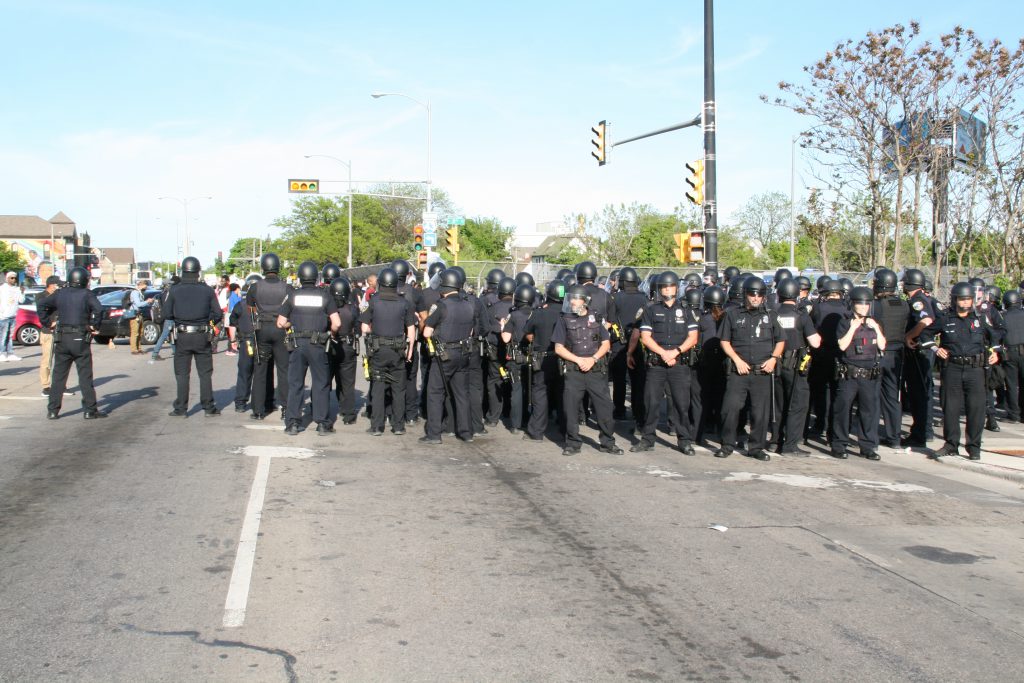How Many Fewer Cops With A 10% Cut?
The number is smaller than 375 officers the Police Department claims, but how much smaller?

Milwaukee Police Department officers block a freeway on-ramp from protesters. Photo by Jeramey Jannene.
How many police officers would be eliminated if the Milwaukee Police Department budget was cut by 10 percent?
It doesn’t appear to be a complicated question, but it is.
The easy answer is 10 percent. If MPD is authorized to have 1,804 officers, a 10 percent cut would reduce the department’s sworn strength by 180.
The department itself believes the answer is over 20 percent and has publicly stated that positions for 375 officers would be eliminated.
After the Common Council announced a proposal to model a 10 percent budget reallocation towards public health, MPD tweeted “A 10% cut in the police budget, or $29.7 million, is the equivalent of approximately 375 police officers. #DidYouKnow.” The move was an escalation of a recent war of words between the department and the council.
But the department’s estimate doesn’t include any cuts to the many other areas of MPD’s $297,366,419 2020 operating budget, including over 800 full-time or full-time-equivalent support staff or non-officer positions.
MPD’s public information office told Urban Milwaukee it used a figure of $79,101 for each officer, which it says reflects all of their fringe benefits including healthcare and pension costs. But the figure is from the 2021 budget request, and only reflects average salary with no benefits.
Benefits, including healthcare and pension costs, represent approximately 27 percent of the department’s entire budget, over $80 million.
Academy trainees earn $44,924 with no benefits, growing to $59,898 when they become sworn officers and $79,856 when they receive their final annual increase. With fringe benefits, sworn officers cost between $88,650 and $118,187 each.
Using the lower budget figure of $88,650 and making no other cuts, a 10 percent budget cut would be reduced to 335 officers. Making it proportional to the amount spent on personnel would reduce it further to 319.
Using the middle point (step three) salary plus benefits figure, $107,713, 276 positions would be eliminated, assuming no other cuts. Going to step five, $118,187, would eliminate 252 positions.
Where would those positions, however many there are, come from? “Losing 375 officers is the equivalent of shutting down District 5, District 7 and Sensitive Crimes. #DidYouKnow,” tweeted the department yesterday.
But that claim represents a much bigger cut than $29.7 million. Cutting those three units would save approximately $37.6 million in 2020 dollars before factoring in fringe benefit savings or any non-personnel cost savings from shuttering buildings. The police department calculation used only the rank-and-file officer costs at each district.
In recent years, any budget cuts have actually been structured to come from the top by eliminating positions through attrition, not layoffs which would require the city to pay unemployment. When an officer retires or leaves the force they’re not replaced. That’s how the 60 officer cut in 2020 is being achieved.
And how much was the 2020 budget cut that resulted in striking 60 sworn officers? Approximately $1.5 million. Much of the staffing cut was driven by a pay increase for officers, not a reduction in spending. Public safety employees are exempt from Act 10, the 2011 state law change that eliminated collective bargaining protections for public-sector unions.
City budget director Dennis Yaccarino has been tasked with answering the question, and exploring where the funds could be reallocated, as part of a Common Council budget modeling request.
Ultimately, what gets cut will be dictated by the city budget. The council has the power to cut positions by line item, including reducing officer counts in specific districts, cutting specific positions or reclassifying others.
The one thing largely out of the council’s control? Overtime. The department is budgeted to spend $17.4 million on overtime in 2020, much of which department leadership has blamed on being short staffed. The figure is included in the operating budget, but can fluctuate. Alderman Robert Bauman has characterized the process as one where the department gets to largely do as it wishes and send the council a bill.
“It’s an issue we do take very seriously,” said MPD chief of staff Nick DeSiato in November 2019 when the council was reviewing the matter. He said at least 13 percent of the cost is simply from officers being subpoenaed and sent to court.
Since 2009 the police budget has grown from $171 million to $297 million, 73.7 percent, while the city budget has grown 14.2 percent.
The department requested a $315 million budget in 2021, up from its $310 million request for 2020.
If you think stories like this are important, become a member of Urban Milwaukee and help support real, independent journalism. Plus you get some cool added benefits.
More about the 2020 Racial Justice Protests
- Plea Agreement Reached On Long-Pending Sherman Park Unrest Charges Involving Vaun Mayes - Jeramey Jannene - Oct 17th, 2024
- Rep. Ryan Clancy Settles With City Following 2020 Curfew Arrest - Jeramey Jannene - Dec 12th, 2023
- Supervisor Clancy Applauds Settlement in Clancy vs. City of Milwaukee - State Rep. Ryan Clancy - Dec 12th, 2023
- Tosa Protest Assails Federal Court Decision Exonerating Police - Isiah Holmes - May 9th, 2023
- Wauwatosa ‘Target List’ Trial Begins - Isiah Holmes - May 3rd, 2023
- Shorewood Spitter Found Guilty For 2020 Protest Confrontation - Jeramey Jannene - Apr 20th, 2023
- City Hall: City Will Pay 2020 George Floyd Protester $270,000 - Jeramey Jannene - Feb 14th, 2023
- Tosa Protest Tickets Dismissed - Isiah Holmes - Jul 21st, 2022
- Op Ed: ‘We Need More’ - Charles Q. Sullivan - Mar 4th, 2022
- Milwaukee Officers Circulate “2020 Riot” Coins? - Isiah Holmes - Nov 14th, 2021
Read more about 2020 Racial Justice Protests here






















Here is a bigger question in this discussion. Are we redirecting these funds to another agency, which will result in less police involvement in specific services?
If police officers aren’t making calls to service to break up student keggers in the UWM area, trying to deal with domestic abuse reports, monitoring traffic violations such as speeding or responding to automobile accident scenes. What if Sheriff’s officers were not required as bailiffs in the courts, or handling building security at the courthouse.
Or are we looking at a punitive action that somehow is going to make law enforcement shape up or ship out?